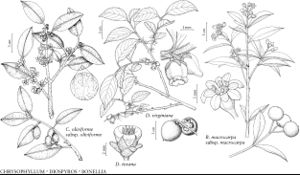Diospyros
Sp. Pl. 2: 1057. 1753.
Gen. Pl. ed. 5, 478. 1754 ,.
Shrubs or trees, usually dioecious; terminal buds absent; wood dense, hard. Leaves deciduous or persistent; petiole often glandular; blade lanceolate to broadly ovate, elliptic, or obovate, coriaceous, surfaces glabrous or pubescent, especially abaxially. Inflorescences 2–15-flowered cymes (staminate) or solitary flowers (pistillate, rarely staminate). Pedicels accrescent in fruit [or not], slender, much shorter to several times longer than flowers. Flowers: sepals persistent, often accrescent in fruit; corolla urceolate to campanulate or salverform, petals usually convolute and imbricate; staminate flowers usually smaller than pistillate flowers; stamens [6–]16(–32), paired and in [1–]2[–5] series; anthers introrse, 2-locular; ovary [3–]8[–16]-locular; ovules 1–2 per locule; styles connate proximally or to near stigmas, slender. Berries yellow, orange, red, purple, brown, or black, fleshy or fibrous. x = 15.
Distribution
se United States, Mexico, West Indies, Central America, South America, Africa, Asia, pantropical in wet to seasonally dry regions at relatively low to moderate elevations with temperate outliers in South America (Argentina, Chile), Asia (China, Japan, Korea).
Discussion
Species 400–500 (4 in the flora).
In addition to the native species, Diospyros kaki Thunberg of eastern Asia, with orange fruits to 10 cm, is cultivated commercially in California and other southern states, and some other species are cultivated as ornamentals. Two of these have become naturalized to a limited extent in Florida. Ebony is obtained from D. ebenum and other Old World species; only the largest individuals of D. virginiana have a narrow, dark core in the heartwood. The total species count for the genus is uncertain because new species are being described and the distinctiveness of some previously described species is questionable. The complicated patterns of variation in some African species of Diospyros led F. White (1962) to coin the term ochlospecies (mob or messy species) for those that are neither monotypic nor conventionally polytypic, with variation tied to geography. The three ochlospecies that he recognized had abundant variation but not in patterns amenable to formal taxonomic recognition. Diospyros virginiana gives some hints of the same kind of variation.
Selected References
None.
Key
| 1 | Leaf blades 2-5 cm, abaxial surface tomentose; flowers on twigs of previous season; anthers of staminate flowers dehiscent by subapical slits; pistillate flowers without staminodes; ovaries pubescent; berries pubescent throughout, black. | Diospyros texana |
| 1 | Leaf blades (5-)6-15(-17) cm, abaxial surface glabrous or sparsely pubescent; flowers on twigs of current season; anthers of staminate flowers dehiscent along entire length; pistillate flowers with staminodes; ovaries glabrous or pubescent; berries glabrous (or pubescent at apex), usually yellow to orange, red, or black | > 2 |
| 2 | Leaf blades with 2 basilaminar glands abaxially; ovaries pubescent; berries (1.5-)2-3 cm diam. | Diospyros maritima |
| 2 | Leaf blades without basilaminar glands abaxially; ovaries glabrous, except sometimes at apex; berries (2-)3-5(-7.5) cm diam | > 3 |
| 3 | Leaf blades: abaxial surface glabrous (or sparsely pubescent, especially when young), apex acute to acuminate; inflorescences solitary flowers or 2-3-flowered cymes; berries yellow to orange or dark red (rarely purple) | Diospyros virginiana |
| 3 | Leaf blades: abaxial surface glabrous, apex rounded to obtuse or barely short- pointed; inflorescences solitary flowers or 3-15-flowered cymes; berries black. | Diospyros ebenum |
